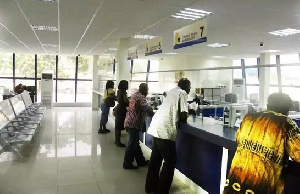 The profit before tax of the banking industry has seen an increase
The profit before tax of the banking industry has seen an increase
The profit before tax (PBT) of the banking industry shot up by 27.4 percent to ¢4.9 billion in the first eight months of this year, signaling a recovery in economic activity.
According to the Bank of Ghana, this is higher than the growth of 19.2 percent registered a year ago.
Over the same comparative period, net interest income grew by 17.9 percent to ¢8.3 billion, marginally lower than the 18.7 percent growth a year ago.
Net fees and commissions grew strongly by 21.8 percent to ¢1.85 billion, higher than the growth of 8.9 percent for the same period last year. This reflected the continued recovery in trade finance-related and other ancillary businesses of banks.
Also, total operating income rose by 15.7 percent, marginally below the corresponding growth rate of 17.0 percent.
Cost control measures within the banking sector continued to support profit performance with operating costs increasing by 9.0 percent, lower than the 12.1 percent increase for the same period in 2020.
For loan loss provisions, it also increased by 5.3 percent, compared with the 29.5 percent growth a year ago. Profit before tax accordingly increased by 27.4 percent to ¢4.9 billion, higher than the growth of 19.2 percent a year ago.
The Bank of Ghana described the banking sector as strong and well-capitalized, with stronger growth in total assets, investments and deposits.
This is represented in the financial statements of the majority of the banks.
Total assets increased by 16.7 percent to ¢166.4 billion as of the end of August 2021, driven mainly by a 28 percent year-on-year growth in investments to ¢80.3 billion.
Also, growth in gross advances rose by 8.7 percent as of August 2021 from the end-June position of 5.7 percent.
Furthermore, the Bank of Ghana said strong liquidity flows during the period resulted in a 21.8 percent annual growth in total deposits to ¢111.6 billion.
On the Financial Soundness Indicators, the Central Bank said it had remained strong, whilst the industry’s Capital Adequacy Ratio of 20.7 percent at the end of August this year, was way above the regulatory minimum threshold of 11.5 percent.
The regulator also said that private sector credit growth has not fully recovered to pre-pandemic (Covid-19) levels due to lingering supply-side risk aversion from the shock of the pandemic as well as slower-than-expected growth in demand for loans that are backed by bankable projects.
The annual nominal growth in private sector credit, therefore, slowed to 9.5 percent in August 2021 compared with 14.3 percent, in the corresponding period of 2020.
Similarly, real private sector credit contracted marginally by 0.1 percent compared to a growth of 3.4 percent, recorded over the same comparative period.